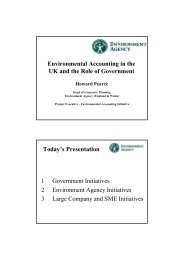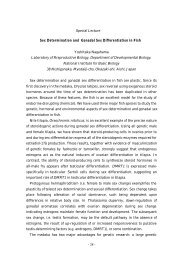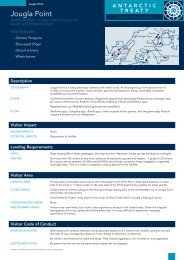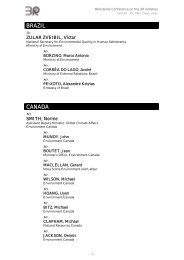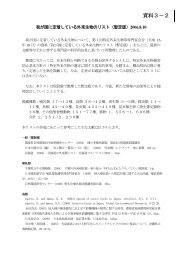Development of the Next Generation Dynamic Olfactometer-Dynascent
Development of the Next Generation Dynamic Olfactometer-Dynascent
Development of the Next Generation Dynamic Olfactometer-Dynascent
You also want an ePaper? Increase the reach of your titles
YUMPU automatically turns print PDFs into web optimized ePapers that Google loves.
3. Researches and <strong>Development</strong>s on Odor Measurement
<strong>Development</strong> <strong>of</strong> <strong>the</strong> <strong>Next</strong> <strong>Generation</strong> <strong>Dynamic</strong> <strong>Olfactometer</strong> – <strong>Dynascent</strong><br />
<strong>Development</strong> <strong>of</strong> <strong>the</strong> <strong>Next</strong> <strong>Generation</strong> <strong>Dynamic</strong> <strong>Olfactometer</strong> – <strong>Dynascent</strong><br />
John Jiang<br />
EnvironOdour Australia Pty Ltd, Sydney, Australia<br />
j.jiang@environodour.com.au<br />
Keywords<br />
Odour, dynamic olfactometer, calibration<br />
Abstract<br />
The introduction <strong>of</strong> an international standard on odour measurement presents a new<br />
challenge for olfactometry laboratories to meet tough new instrumental performance<br />
and panellist performance criteria. The paper reviews a number <strong>of</strong> olfactometers used<br />
in <strong>the</strong> last ten years both in Australia and overseas. It has found that <strong>the</strong> back<br />
pressure could contribute a significant error in <strong>the</strong> delivery <strong>of</strong> <strong>the</strong> required dilution ratio<br />
and <strong>the</strong> contamination <strong>of</strong> <strong>the</strong> olfactometer was <strong>the</strong> source <strong>of</strong> large variation in<br />
olfactometry results. The paper discusses <strong>the</strong> instrumental performance <strong>of</strong> <strong>the</strong> newly<br />
developed olfactometer. DynaScent is a fourth generation olfactometer which uses no<br />
flow measurement device (flowmeter or mass flow controller). The dilution ratios <strong>of</strong> <strong>the</strong><br />
DynaScent were calibrated using CO gas and auto calibration feature. The effects <strong>of</strong><br />
<strong>the</strong> CO sampling point locations (within <strong>the</strong> system and above <strong>the</strong> sniffing cup) could<br />
have significant impacts on <strong>the</strong> dilution ratio. Practically, <strong>the</strong> manual calibration is both<br />
time consuming and labour intensive. Fur<strong>the</strong>rmore, it was found that <strong>the</strong> accuracy and<br />
instability results were sensitive to <strong>the</strong> selection <strong>of</strong> <strong>the</strong> CO gas range. It is concluded<br />
that <strong>the</strong> calibration <strong>of</strong> a dynamic olfactometer should be carried out more frequently<br />
than once a year. The DynaScent olfactometer was able to achieve averaged<br />
instability <strong>of</strong> 1.7% and accuracy <strong>of</strong> 9% over <strong>the</strong> dilution range <strong>of</strong> 2 - 65000.<br />
1. INTRODUCTION<br />
Uncertainty in odour measurement is a major concern to environmental regulators,<br />
researchers, and stakeholders 1 . The large variations in odour concentrations have<br />
limited <strong>the</strong> use <strong>of</strong> dynamic olfactometry results in <strong>the</strong> regulations in <strong>the</strong> United States<br />
and European countries. In some studies, <strong>the</strong> olfactometry method was considered to<br />
be “comparable” within <strong>the</strong> studies and was not compatible to o<strong>the</strong>r studies due to<br />
different olfactometry standards being used. The reliability <strong>of</strong> odour measurements<br />
has <strong>of</strong>ten been debated in environmental courts. Odour is <strong>the</strong> most contentious issue<br />
in environmental regulations.<br />
Berglund et al 2 suggested that “A substantial proportion <strong>of</strong> <strong>the</strong> large variation attributed<br />
to <strong>the</strong> observers in odor studies, originates from olfactometric malperformance”. A<br />
more recent study at <strong>the</strong> University <strong>of</strong> Minnesota indicated that “Sample and<br />
supplemental airflow rates were significantly different at <strong>the</strong> beginning and end <strong>of</strong> a<br />
typical session” with <strong>the</strong>ir mass flow based olfactometer 3 . Jiang also confirmed that<br />
<strong>the</strong> ability <strong>of</strong> dynamic in delivering <strong>the</strong> required dilution radio over many sessions <strong>of</strong><br />
-109-
<strong>Development</strong> <strong>of</strong> <strong>the</strong> <strong>Next</strong> <strong>Generation</strong> <strong>Dynamic</strong> <strong>Olfactometer</strong> – <strong>Dynascent</strong><br />
odour testing is one <strong>of</strong> <strong>the</strong> two critical factors and suggested that <strong>the</strong> instrumental<br />
calibration should be carried out in more frequent than once per year 4 .<br />
The importance <strong>of</strong> instrument calibration to determine <strong>the</strong> dilution ratio and panel<br />
management to monitor individual panellist performance over standard odorant (such<br />
as n-butanol) is also disputed among <strong>the</strong> pr<strong>of</strong>essionals. Most commercial<br />
olfactometers did not produce <strong>the</strong> instrumental accuracy and instability from <strong>the</strong> tracer<br />
gas calibration results over <strong>the</strong> entire dilution range as required in <strong>the</strong> standards. van<br />
Harreveld et al. reviewed 20 years <strong>of</strong> olfactometry development in Europe and<br />
concluded that panel selections and span adjustment were <strong>the</strong> only two “crucial”<br />
steps 5 . Span adjustment meant that “laboratories could adjust <strong>the</strong>ir method to achieve<br />
<strong>the</strong> same value for <strong>the</strong> odour unit: 1 ou/m 3 = 40 ppbv n-butanol.” Jiang noted that<br />
meeting <strong>the</strong> instrumental performance and panellist performance criteria was a major<br />
challenge for olfactometry laboratories in <strong>the</strong> implementation <strong>of</strong> <strong>the</strong> Australian<br />
standard 1 .<br />
The calibration <strong>of</strong> any analytical instrument is <strong>the</strong> first step toward producing reliable<br />
testing results. Odour measurement is no exception and instrumental calibration is <strong>the</strong><br />
most important step in controlling uncertainty during <strong>the</strong> measurement to ensure <strong>the</strong><br />
delivery <strong>of</strong> <strong>the</strong> required dilution ratio. There are two assessment criteria. The<br />
accuracy <strong>of</strong> <strong>the</strong> dilution apparatus ensures that <strong>the</strong> dilution ratio between five series is<br />
delivered within 20% <strong>of</strong> <strong>the</strong> set dilution ratio. The instability <strong>of</strong> <strong>the</strong> dilution apparatus<br />
ensures <strong>the</strong> same dilution ratio is given to all <strong>the</strong> panellists within 5% <strong>of</strong> <strong>the</strong> expected<br />
values in <strong>the</strong> same dilution step 6, 7 .<br />
Unfortunately, some olfactometers are not so easy to calibrate. For example, those<br />
olfactometers that use sniffing masks have some difficulties in confirming <strong>the</strong> dilution<br />
ratio at <strong>the</strong> time when <strong>the</strong> panellist is sniffing. Consequently, an uncalibrated<br />
olfactometer undoubtedly affects <strong>the</strong> panel selection and results in <strong>the</strong> panellists’<br />
making inappropriate assessment <strong>of</strong> <strong>the</strong> odour. As a result, <strong>the</strong> odour concentrations<br />
measured using <strong>the</strong> uncalibrated olfactometer might suffer from poor accuracy and<br />
instability.<br />
During <strong>the</strong> 1980s, considerable effort was made in developing olfactometric odour<br />
measurement techniques in <strong>the</strong> Ne<strong>the</strong>rlands and elsewhere in Europe 8, 9 . Initially, <strong>the</strong><br />
application <strong>of</strong> <strong>the</strong>se olfactometric results was limited mainly to comparing odour<br />
emissions from various manure treatment systems in intensive animal production. In<br />
1985, <strong>the</strong> Victoria EPA in Australia first introduced legislation based on olfactometer<br />
results and air dispersion model (Ausplume). In North America, despite earlier interest<br />
in olfactometric measurement techniques during <strong>the</strong> 1970s, it was not until <strong>the</strong> mid<br />
1990s that North American universities set up olfactometry laboratories to investigate<br />
odour from animal production.<br />
The development <strong>of</strong> olfactometric measurement techniques continued in Europe and<br />
resulted in <strong>the</strong> introduction <strong>of</strong> <strong>the</strong> first draft European Standard for odour measurement<br />
-110-
<strong>Development</strong> <strong>of</strong> <strong>the</strong> <strong>Next</strong> <strong>Generation</strong> <strong>Dynamic</strong> <strong>Olfactometer</strong> – <strong>Dynascent</strong><br />
by dynamic olfactometer. In Australia, a national workshop on odour measurement<br />
standardization was held in 1997 and consensus was reached to adopt <strong>the</strong> draft<br />
European standard. In 2001, Australia published <strong>the</strong> first <strong>of</strong>ficial standard ahead <strong>of</strong><br />
European countries. European countries have <strong>of</strong>ficially agreed to adopt <strong>the</strong> CEN<br />
standard in early 2003.<br />
In summary, most olfactometers currently used around <strong>the</strong> world can be categorised in<br />
three groups on <strong>the</strong> basis how <strong>the</strong> dilution is achieved:<br />
• static method (syringe method in USA, triangle bags in Japan);<br />
• rotameter/fixed orifice based olfactometers (VIC. EPA B2 in Australia, TO7 in<br />
Germany, IITRI in USA) and<br />
• Mass Flow Controller (MFC) based olfactometers (Ac’scent olfactometer in USA,<br />
Olfaktomat as used in <strong>the</strong> Ne<strong>the</strong>rlands).<br />
Static method utilises <strong>the</strong> syringe to make <strong>the</strong> necessary dilution. The error in<br />
reproducing <strong>the</strong> necessary dilution ratio is so large. The flow rates at <strong>the</strong> sniffing ports<br />
are so low. The manual operation can no long meet <strong>the</strong> requirements specified in<br />
Australia and European standards.<br />
Rotameter based olfactometers are currently used in many laboratories in Australia<br />
and elsewhere. The rotameters are extremely sensitive to downstream pressure<br />
variations that could result in errors in rotameter readings <strong>of</strong> up to 25%. Such<br />
pressure variations may be occurred during <strong>the</strong> mixing <strong>of</strong> clean air and odorous air to<br />
create <strong>the</strong> required dilution radio or subsequently during <strong>the</strong> sample presentation <strong>of</strong><br />
<strong>the</strong> diluted sample. The latter may be accentuated by <strong>the</strong> use <strong>of</strong> an enclosed sniffing<br />
mask, adversely affecting overall performance <strong>of</strong> <strong>the</strong> olfactometer. The manual mode<br />
<strong>of</strong> operation for rotameter based olfactometers makes it impossible to meet stringent<br />
instrumental performance criteria, particularly at <strong>the</strong> high dilution ratio end <strong>of</strong> <strong>the</strong> range.<br />
Fur<strong>the</strong>rmore, high labour costs when using manual data input for monitoring panellist<br />
performance and in <strong>the</strong> data processing used for retrospective screening may also<br />
make compliance with <strong>the</strong> proposed standard excessively expensive.<br />
In contrast, automated, MFC based olfactometers have demonstrated an inherent<br />
ability to comply with both instrumental and panellist performance criteria. But <strong>the</strong><br />
MFC based olfactometers are also sensitive to <strong>the</strong> downstream pressure <strong>of</strong> <strong>the</strong> flow<br />
measurement devices. The backpressure occurring during mixing can be<br />
compensated for by instrumental calibration. However, pressure variations occurring<br />
during <strong>the</strong> sample presentation stage cannot be predicted and <strong>the</strong>refore cannot be<br />
compensated for by calibration. Backpressures can vary from panellist to panellist. In<br />
practice, <strong>the</strong> reduced flow arising from <strong>the</strong> specific personal characteristics <strong>of</strong> a<br />
panellist will be sensed by <strong>the</strong> mass flow meter resulting in <strong>the</strong> valve being fur<strong>the</strong>r<br />
opened. However, <strong>the</strong> presentation time for each panellist is long (10 – 30 seconds) in<br />
comparison with <strong>the</strong> response time <strong>of</strong> <strong>the</strong> mass flow controller to change <strong>the</strong> valves<br />
(several seconds). These unstable conditions will be repeated many times during <strong>the</strong><br />
-111-
<strong>Development</strong> <strong>of</strong> <strong>the</strong> <strong>Next</strong> <strong>Generation</strong> <strong>Dynamic</strong> <strong>Olfactometer</strong> – <strong>Dynascent</strong><br />
session. As a result, <strong>the</strong> actual dilutions <strong>of</strong> odour samples at <strong>the</strong> sniffing ports can be<br />
highly variable.<br />
Fur<strong>the</strong>rmore, <strong>the</strong> MFCs are susceptible to contamination buildup that can alter <strong>the</strong><br />
calibration and result in <strong>the</strong> reduced performance. The tiny space between <strong>the</strong><br />
temperature elements inside <strong>the</strong> mass flow meter can be easily contaminated or<br />
blocked. The MFC is really designed for single component gas and better suited to a<br />
clean and non-sticky gas. In particular, <strong>the</strong> odour samples can sometime be very<br />
sticky and dusty. Therefore, MFC based olfactometers could easily suffer from <strong>the</strong><br />
poor performance <strong>of</strong> <strong>the</strong> MFCs during <strong>the</strong> operation. This has proved to be a major<br />
limitation in <strong>the</strong> use <strong>of</strong> MFC based olfactometers. Flushing <strong>the</strong> MFCs may take hours<br />
and is not effective at all. Over a period <strong>of</strong> usage, dust and residuals eventually<br />
become irreversibly adhered to <strong>the</strong> surfaces <strong>of</strong> <strong>the</strong> temperature elements and <strong>the</strong> MFC<br />
must be replaced. The performance <strong>of</strong> MFC based olfactometer in delivering <strong>the</strong><br />
required dilution radio can not guaranteed.<br />
2. METHODOLOGY<br />
The DynaScent olfactometer is a fourth generation dynamic olfactometer which is fully<br />
computer controlled and uses no flow measurement devices (The DynaScent<br />
<strong>Olfactometer</strong>, EnvironOdour Australia Pty Ltd, 2003). The sample is mixed with<br />
odourfree air within a custom designed venturi gas jet. The dilution ratios are adjusted<br />
by a series <strong>of</strong> needle valves controlled by <strong>the</strong> digital precision motion controller with<br />
±0.0001 revolution accuracy. The repeatability <strong>of</strong> <strong>the</strong> dilution is purely based on <strong>the</strong><br />
mechanical repeatability which is capable to reproduce highly repeatable dilution ratio.<br />
The precision needle valves can be dismantled and cleaned to minimise <strong>the</strong> effects <strong>of</strong><br />
<strong>the</strong> contamination. The variation in <strong>the</strong> dilution ratios during <strong>the</strong> sample mixture and<br />
during <strong>the</strong> panellist sniffing is minimised by <strong>the</strong> use <strong>of</strong> <strong>the</strong> critical nozzle and <strong>the</strong><br />
improved sniffing cups.<br />
Carbon monoxide was chosen as a tracer because CO is a non-reactive gas and<br />
because <strong>of</strong> <strong>the</strong> reliability <strong>of</strong> CO gas monitors. Due to <strong>the</strong> limited detection range in <strong>the</strong><br />
gas monitor, a series <strong>of</strong> CO gases were used so that <strong>the</strong> final gas concentrations at<br />
<strong>the</strong> sniffing cup were within <strong>the</strong> detection range <strong>of</strong> <strong>the</strong> gas analyzer. The CO gas was<br />
loaded as a normal sample and placed within <strong>the</strong> sampling drum. A Monitor Labs<br />
9830 CO analyzer (range from 0 to 200 ppm), calibrated by an accredited laboratory,<br />
was used to determine <strong>the</strong> CO concentration at <strong>the</strong> sniffing cup.<br />
The following table lists <strong>the</strong> range <strong>of</strong> CO gases used in <strong>the</strong> calibration.<br />
-112-
<strong>Development</strong> <strong>of</strong> <strong>the</strong> <strong>Next</strong> <strong>Generation</strong> <strong>Dynamic</strong> <strong>Olfactometer</strong> – <strong>Dynascent</strong><br />
Table 1 CO concentrations at source and cup<br />
Dilution step Dilution range CO conc. at source, Expected CO conc. at cup,<br />
ppm<br />
ppm<br />
1 – 4 2 – 16 162 81 – 10<br />
5 – 8 32 – 256 4,840 150 – 20<br />
9 – 12 512 – 8,192 100,000 195 – 24<br />
13 – 19 16,384 –<br />
524,288<br />
1,000,000 122 – 2<br />
The signal output <strong>of</strong> <strong>the</strong> CO analyzer was connected into <strong>the</strong> DynaScent olfactometer<br />
for direct display <strong>of</strong> CO readings and data logging. The <strong>Dynascent</strong> automatically starts<br />
a dilution step, takes 10 CO readings over 100 seconds (one reading every 10<br />
seconds), <strong>the</strong>n moves to <strong>the</strong> next dilution step and takes 10 CO readings, until all <strong>the</strong><br />
steps are completed. This process is <strong>the</strong>n repeated five times. The CO results are<br />
used to calculate <strong>the</strong> accuracy and instability <strong>of</strong> <strong>the</strong> olfactometer as per <strong>the</strong> Australian<br />
and New Zealand standard 6 .<br />
Figure 1 Calibration setup<br />
Figure 1 illustrates <strong>the</strong> calibration setup. A second CO monitor was used to monitor<br />
<strong>the</strong> CO concentration in <strong>the</strong> room to keep it below 15 ppm at all times for safety<br />
reasons. A flow meter with a range <strong>of</strong> 4 – 40 Liters Per Minute (LPM) was used to<br />
calibrate <strong>the</strong> flow rate at <strong>the</strong> sniffing ports. Before <strong>the</strong> calibration <strong>of</strong> <strong>the</strong> dilution ratio,<br />
<strong>the</strong> flow rates were checked to be 20 LPM at both sniffing ports before and after <strong>the</strong><br />
completion <strong>of</strong> <strong>the</strong> dilution adjustment.<br />
3. RESULTS AND DISCUSSION<br />
Instrumental calibration <strong>of</strong> an olfactometer is time consuming and labour intensive.<br />
Calibration <strong>of</strong> <strong>the</strong> olfactometer involves hundreds <strong>of</strong> measurements (950 single<br />
measurements comprising 50 measurements for each dilution step for a 19-step<br />
-113-
<strong>Development</strong> <strong>of</strong> <strong>the</strong> <strong>Next</strong> <strong>Generation</strong> <strong>Dynamic</strong> <strong>Olfactometer</strong> – <strong>Dynascent</strong><br />
olfactometer). The process could take up to five days if adjustment <strong>of</strong> <strong>the</strong> instrument<br />
setting is required for a MFC based olfactometer. Consequently, <strong>the</strong> inclusion <strong>of</strong> an<br />
automated calibration feature in <strong>the</strong> olfactometer is necessary.<br />
The location <strong>of</strong> <strong>the</strong> sampling tubing could have an effect on <strong>the</strong> CO readings. As<br />
shown in Figure 2, CO concentrations at <strong>the</strong> sniffing cups (Figure 2, right) were 40%<br />
smaller than those collected in <strong>the</strong> tubing (Figure 2, left) which was below <strong>the</strong> sniffing<br />
cup. Initially, it was suspected that extra gas went into <strong>the</strong> gas analyzer to cause <strong>the</strong><br />
large bias. A bulb flow meter was used to measure <strong>the</strong> sampling rate <strong>of</strong> <strong>the</strong> CO<br />
analyzer. It was found that <strong>the</strong>re was no difference between <strong>the</strong>se two arrangements.<br />
The only possibility was that <strong>the</strong> open space in <strong>the</strong> cup might dilute <strong>the</strong> CO<br />
concentrations. In this study, <strong>the</strong> sampling at <strong>the</strong> sniffing cup was used.<br />
Figure 2 Sampling arrangement<br />
Figure 3 shows <strong>the</strong> consecutive CO concentrations for dilution steps 5 – 8 over 45<br />
minutes. The results are distributed over a narrow range which depends on <strong>the</strong><br />
expected concentrations. The results show a higher CO variation (130 – 162 ppm) at<br />
<strong>the</strong> higher expected CO concentration (150 ppm) and a lower CO variation (19 – 22<br />
ppm) at <strong>the</strong> lower expected CO concentration (20 ppm). These variations were likely<br />
caused by <strong>the</strong> CO gas analyser.<br />
The accuracy (expressed as a bar chart) and instability (expressed as a single line<br />
chart) <strong>of</strong> <strong>the</strong> dynamic olfactometer are shown in Figure 4. The results show an<br />
excellent instability <strong>of</strong> 1.7% for <strong>the</strong> dilution step <strong>of</strong> 1 - 16 and an increased instability<br />
for <strong>the</strong> dilution step <strong>of</strong> 17 - 19. This was caused by <strong>the</strong> small CO concentrations, less<br />
than 10 ppm. The averaged accuracy <strong>of</strong> <strong>the</strong> olfactometer is 9% over <strong>the</strong> range <strong>of</strong> 2 -<br />
65000. The accuracy <strong>of</strong> <strong>the</strong> instrument seems to be more sensitive to <strong>the</strong> absolute CO<br />
concentration levels at <strong>the</strong> sniffing cup.<br />
-114-
CO conc., ppm<br />
CO conc., ppm<br />
165<br />
155<br />
145<br />
135<br />
125<br />
37<br />
36<br />
35<br />
34<br />
33<br />
25%<br />
20%<br />
15%<br />
10%<br />
5%<br />
0%<br />
-5%<br />
-10%<br />
-15%<br />
-20%<br />
-25%<br />
Step 5<br />
1 2 3 4 5 6 7 8 9 10<br />
Sequential reading<br />
Step 7<br />
1 2 3 4 5 6 7 8 9 10<br />
Sequential reading<br />
<strong>Development</strong> <strong>of</strong> <strong>the</strong> <strong>Next</strong> <strong>Generation</strong> <strong>Dynamic</strong> <strong>Olfactometer</strong> – <strong>Dynascent</strong><br />
CO conc., ppm<br />
CO conc., ppm<br />
-115-<br />
90<br />
85<br />
80<br />
75<br />
70<br />
22<br />
21<br />
20<br />
19<br />
18<br />
Step 6<br />
1 2 3 4 5 6 7 8 9 10<br />
Sequential reading<br />
Step 8<br />
1 2 3 4 5 6 7 8 9 10<br />
Sequential reading<br />
Figure 3 CO concentrations at dilution steps 5 – 8<br />
Accuracy Instability<br />
1 2 3 4 5 6 7 8 9 10 11 12 13 14 15 16 17 18 19<br />
Dilution steps<br />
Figure 4 Accuracy and instability <strong>of</strong> <strong>the</strong> dynamic olfactometer
<strong>Development</strong> <strong>of</strong> <strong>the</strong> <strong>Next</strong> <strong>Generation</strong> <strong>Dynamic</strong> <strong>Olfactometer</strong> – <strong>Dynascent</strong><br />
4. CONCLUSIONS<br />
Instrumental calibration is a fundamental issue for dynamic olfactometers in<br />
addressing uncertainty. Unfortunately, <strong>the</strong> calibration <strong>of</strong> such instruments is both time<br />
consuming and labour intensive. It is understood that most laboratories around <strong>the</strong><br />
world do not perform <strong>the</strong> calibrations <strong>of</strong> dilution ratios. Some olfactometers do not<br />
have a feature to allow <strong>the</strong> end-users to adjust <strong>the</strong> olfactometer.<br />
The performance <strong>of</strong> <strong>the</strong> flow meter and MFC based olfactometers was found to<br />
degrade over time. This could be caused by <strong>the</strong> accumulation <strong>of</strong> dirt on <strong>the</strong> contact<br />
surfaces and <strong>the</strong> change <strong>of</strong> operating conditions. The calibration <strong>of</strong> a dynamic<br />
olfactometer should be carried out more frequently than once a year as suggested in<br />
<strong>the</strong> standard. A procedure should be in place to check <strong>the</strong> accuracy <strong>of</strong> <strong>the</strong><br />
olfactometer frequently so that <strong>the</strong> performance <strong>of</strong> <strong>the</strong> olfactometer can be monitored.<br />
A full instrumental calibration should be carried out if necessary.<br />
The study discussed several important aspects <strong>of</strong> instrumental calibration. The<br />
selection <strong>of</strong> sampling points during <strong>the</strong> calibration might produce different calibration<br />
results. Sampling within <strong>the</strong> sniffing cup is recommended since <strong>the</strong> arrangement is<br />
similar to <strong>the</strong> nose’s position during <strong>the</strong> sniffing. The selection <strong>of</strong> CO gas<br />
concentrations can also affect <strong>the</strong> measured accuracy and instability. The fact that <strong>the</strong><br />
calibration results are subject to <strong>the</strong> selection <strong>of</strong> <strong>the</strong> CO concentrations suggested that<br />
<strong>the</strong> use <strong>of</strong> CO to calibrate <strong>the</strong> olfactometer may not be <strong>the</strong> best technique. A more<br />
sensitive analytical instrument with sensitivity to a low ppb level should be used.<br />
The instrumental performance <strong>of</strong> <strong>the</strong> DynaScent olfactometer has been demonstrated<br />
by CO gas calibration. Overall, <strong>the</strong> DynaScent olfactometer could achieve an<br />
averaged instability <strong>of</strong> 1.7% and an averaged accuracy <strong>of</strong> 9% over <strong>the</strong> dilution range <strong>of</strong><br />
2 – 65000 (step 1 – step 16).<br />
References<br />
1) Jiang, J., What are <strong>the</strong> areas for fur<strong>the</strong>r research? Water Science & Technology, Vol 44 No 9 pp<br />
17-25 © IWA Publishing 2001<br />
2) Berglund, B., Berglund, U. and Lindvall, T. (1987). Quality assurance in olfactometry, in <strong>the</strong><br />
proceedings <strong>of</strong> “Volatile emissions from livestock farming and sewage operations” edited by<br />
Nielsen V.C., Voorburg J. H. and L’Hermite P.; Uppsala, Sweden, 10-12 June 1987, 12-25<br />
3) Department <strong>of</strong> Biosystems and Agricultural Engineering, <strong>the</strong> University <strong>of</strong> Minnesota, Last<br />
updated 12/13/3902, http://www.bae.umn.edu/annrpt/1998/ research/lvstk2.html<br />
4) Jiang, J., Towards odour measurement standardisation on dynamic olfactometer, Proceedings <strong>of</strong><br />
<strong>the</strong> National Workshop on Odour Measurement Standardization, August 20-22 1997, Sydney,<br />
Australia, pp 33-41<br />
5) van Harreveld, A. P., Heeres, P. and Harssema, H. (1999), A Review <strong>of</strong> 20 Years <strong>of</strong><br />
Standardization <strong>of</strong> Odor Concentration Measurement by <strong>Dynamic</strong> Olfactometry in Europe, J. Air &<br />
Waste Management. Assoc. Vol. 49, pp. 705-715<br />
6) Australian and New Zealand Standard, AS 4323.3, 2001, Stationary source emissions: Part 3:<br />
Determination <strong>of</strong> odour concentration by dynamic olfactometry<br />
-116-
<strong>Development</strong> <strong>of</strong> <strong>the</strong> <strong>Next</strong> <strong>Generation</strong> <strong>Dynamic</strong> <strong>Olfactometer</strong> – <strong>Dynascent</strong><br />
7) CEN (Comitté Européen de Normalisation), 2001, Standard prEN 13725, “Air Quality –<br />
Determination <strong>of</strong> odour concentration by dynamic olfactometry”<br />
8) Hangartner, H., Hartung, J. and Voorbury, J. H. (1985). Recommendations <strong>of</strong> olfactometric<br />
measurements. Environmental Technology Letters, Vol. 6, 415-420<br />
9) Hangartner, M., Hartung, J., Paduch, M., Pain, B. F. and Voorbury, J. H. (1989). Improved<br />
recommendations <strong>of</strong> olfactometric measurements, Environmental Technology Letters, 10, 231-<br />
236<br />
-117-



![Presentation Material [PDF 1664KB]](https://img.yumpu.com/23394763/1/190x132/presentation-material-pdf-1664kb.jpg?quality=85)
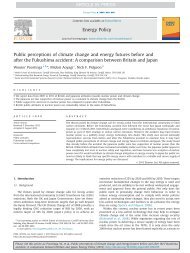
![List of Participants[PDF 221KB]](https://img.yumpu.com/22029974/1/184x260/list-of-participantspdf-221kb.jpg?quality=85)

![Presentation Material [PDF 4494KB]](https://img.yumpu.com/22029884/1/190x143/presentation-material-pdf-4494kb.jpg?quality=85)
